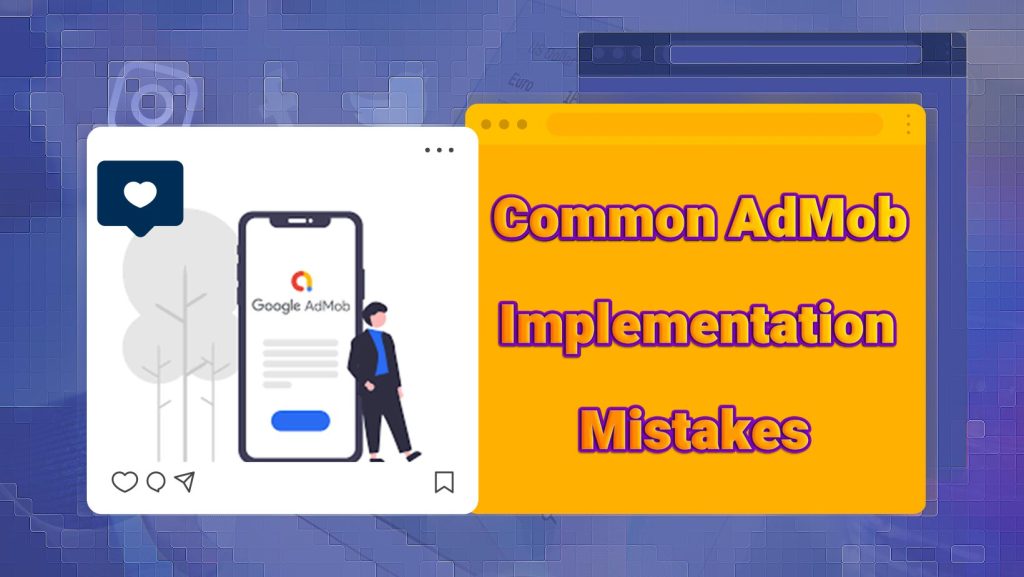Some people are facing issues with AdMob in their app. Maybe they see blank ad spaces or the dreaded AdMob account suspension. This can happen to everyone, so do not feel alone!
Integrating AdMob can be tricky; even professional developers fall prey to common mistakes.
The article focuses on mistakes during the implementation stage before the app reaches users and offers solutions and resources to avoid these problems.
These mistakes can lead to issues like ads not showing up or even getting your AdMob account suspended.
We will discuss the most frequent AdMob implementation mistakes that can tank your ad revenue and user experience.
If you are ready, let’s get your app’s monetization strategy!
What Are the Common AdMob Implementation Mistakes?
AdMob is a fantastic tool for developers and publishers to earn money by showing app ads. But, just like building your app, implementing AdMob can have some bumps along the road.
If you’ve decided to use AdMob to monetize your excellent app, you have made a great choice. But if you need help with AdMob implementation, you should make one of these common mistakes.
Don’t worry—these mistakes are fixable. By understanding them, you can avoid frustration and stop losing income.
![]() Here are 6 of the most common AdMob implementation mistakes and how to fix them:
Here are 6 of the most common AdMob implementation mistakes and how to fix them:
1. Misplaced Ad Units
Just as putting a billboard in an alleyway where few people will see it is a common mistake, misplacing the ad units is another.
Placing ads where users cannot easily see them, like behind menus or during intense gameplay moments, is a big mistake, and you must avoid it.

What is the solution?
While placing your ads, you must consider your app’s natural flow and user experience. You can place ads between levels, during natural pauses, or at the bottom of scrollable content. Find the areas where users are likely to glance or take a break.
2. Forgetting Test Ads
It is not testing in one of those critical stages that are commonly mistakenly ignored! This is crucial before launching your app.
If you skip this step, users will open your app to find something but blank ad spaces, which could be a better first impression! Let’s fix it!
How do we fix this issue?
You can use AdMob’s test ad unit IDs to remedy this issue. These allow you to see different ad formats and ensure everything functions properly before going live.
3. Ignoring Ad Limits
The other AdMob integration mistakes are related to the limits. There are limits to how many ads you can display per user per hour.
Going overboard with ads can be a significant turn-off for users and might even get your AdMob account flagged.
What can be the solution?
Be mindful of ad frequency. AdMob offers tools to set limits and certify a smooth user experience. All you have to do is keep a balance that brings in revenue without overwhelming users.
4. Incorrect Ad Unit IDs
This might seem simple, but typos happen! Using the wrong ad unit ID is a surefire way to get blank ad spaces, and it is considered one of the common mistakes in AdMob implementation.
How to solve it?
Double- and triple-check your ad unit IDs to ensure they match exactly the ones you copied from your AdMob account.

5. Not Following AdMob Policies
You need to know that the following roles will safeguard your path in AdMob monetization.
As you already know, AdMob has policies to ensure a positive user experience. Violating these policies could lead to account suspension, which you do not want.
Let’s see what you can do about it.
What are the ways to get over this issue?
Take some time to familiarize yourself with AdMob’s policies. They are easy to understand, and following them will keep your account safe and your ads running smoothly.
6. Ignoring User Consent
With data privacy regulations on the rise, it’s crucial to obtain user consent before collecting and using data for ad targeting.
How can we get rid of this matter?
You only need to implement a clear and user-friendly consent mechanism within your app that complies with relevant regulations.
If you avoid these common mistakes and follow these simple solutions, you can easily be more successful in AdMob implementation.
All you need to remember is that some planning goes a long way, and a well-integrated AdMob can be a significant revenue stream for your app.
![]() Here are some additional tips to consider when implementing AdMob:
Here are some additional tips to consider when implementing AdMob:
- Prioritize User Experience: The core purpose of your app should always come first. Ensure a smooth user experience by placing ads in disruptive locations or overwhelming users.
- Maintain Transparency: Be upfront with users about how you’re using AdMob. Consider including a short explanation within your app’s privacy policy.
- Reward Loyal Users: There are ways to incentivize users who see and interact with ads. One strategy is to offer in-app rewards or bonus features.
These are all the tips you can use for even better monetizing through AdMob.
To Wrap It Up
In this section, we added 6 common AdMob implementation mistakes. By understanding and avoiding these mistakes, you can secure a smooth path to maximizing your ad revenue without compromising user experience.
But as you know, you do not have to sit aside after fixing all these mistakes! Mobile app monetization is ever-changing, so you must keep yourself up-to-date. Doing so can add more value to your website and satisfy users and visitors.
We’d love to hear your thoughts and experiences, so please answer the following: Have you encountered any AdMob challenges or made one of these common mistakes? Please share your wins and woes in the comments below and start a conversation.


